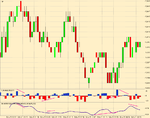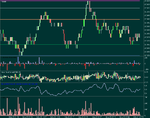christop said:dcraig1,
Thank you for your response and clearing many items up.
Great to see the chart.
I’d like to see it in action in our markets and the response it would create?
Do you find the same sort of patterns reoccurring as you mention and then couple these with price patterns? and other analysis etc.
I would believe you would have a higher success rate of trades too because your adding another dimension to your trade analysis, well done.
I’m wondering if anyone has attempted or written an ela (Tradestation) code for such a task.
Great work dcraig1, I can see the validity of how it assists in your trading.
I notice your in Brisbane do you trade the Aussie futures markets as well?
How much is the data feed cost from IB?
I shall continue my quest in self improvement and once again thank you for your time and assistance.
I’m always on the look-out for ways to improve trading results.
Christop
IB data feed is "freeish" - there are fees for some exchanges and not others. It is my understanding that IB just passes on what the exchange charges them.
Free: SNFE, SGX (Singapore) , KSE (Korea), HKFE (Hong Kong) and others.
US: free for stocks, options and futures if you do more than $30 commission per month. Otherwise $10
European markets (Eurex, Liffe etc): various charges.
There are some limitations:
100 instruments maximum concurrently
3 L2 streams max concurrent
The feed does not report every tick. There is a kind of aggregation with a Max of 3 - 4 updates per second. I'm of the opinion that this is not very important to most people. Some maintain they need a true tick feed, though with some exchanges doing tick aggregation themselves, just what is true tick feed is, is open to interpretation. However because of the way it works, it tends to be very fast and keep up with fast markets very well.
As for doing this sort of thing in Tradestation, I dunno. You might have to resort to writing a DLL. I don't know anything about Tradestation, so I'm not the right person to ask.
I believe that the type of pattern illustrated is typical of stock index futures. Obviously different instruments have different characteristics - volatility, liquidity etc so things are certainly going to vary. I'll try to save an SPI chart tomorrow, and post it.
I'm not especially hot on price patterns, but I like to keep the following automatically drawn on charts: floor pivots, market profile levels, developing market profile VAs, developing VWAP, previous day's VWAP. Of course one should always keep an eye on potential horizontal S/R levels. I think I prefer charts with constant volume bars - trends and channels are IMHO clearer, though time charts also convey volume info in an essential form.


